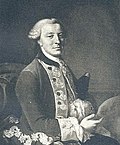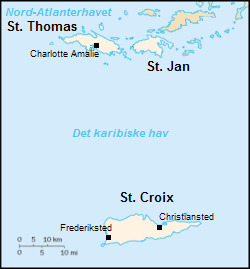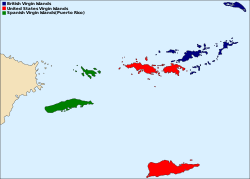| Portrait | Incumbent | Term | Notes |
|---|
| 1 | | Gabriel Milan | 7 May 1684 – 27 February 1686 | |
| 2 | | Mikkel Mikkelsen (interim) | 27 February 1686 – 29 June 1686 |
| 3 | | Christopher Heins | 29 June 1686 – March 1687 | |
| 4 | | Adolph Esmit (interim) | March 1687 – October 1688 | Second term |
| 5 | | Christopher Heins | October 1688 – October 1689 | Second term |
| 6 | | Johan Lorensen | October 1689 – 17 September 1692 | |
| 7 | | Frans de la Vigne | 17 September 1692 – 7 April 1693 | |
| 8 | | Johan Lorensen | 7 April 1693 – 19 February 1702 | Second term |
| 9 | | Claus Hansen | 19 February 1702 – 8 February 1706 |
| 10 | | Joachim Melchior von Holten | 8 February 1706 – 21 December 1708 | |
| 11 | | Diderich Mogensen | 21 December 1708 – 1710 |
| 12 | | Mikkel Knudsen Crone | 1710 – 8 August 1716 |
| 13 | | Erik Bredal | 8 August 1716 – April 1724 | During his term St. John was occupied. |
| 14 | | Friderich Moth | April 1724 – May 1727 |
| 15 | | Henrich von Suhm | May 1727 – 21 February 1733 |
| 16 | | Phillip Gardelin [ da; no ] | 21 February 1733 – 21 February 1736 | During his term there was a slave rebellion. |
| 17 | | Friderich Moth | 21 February 1736 – 13 April 1744 | Second term. Also governor of St. Croix (see below). |
| 18 | | Jacob Schönemann | 1740 – 1744 |
| 19 | | Christian von Schweder | 13 April 1744 – 25 April 1747 |
| 20 | | Christian Suhm | 25 April 1747 – 1758 |
| 21 | | Harrien Felschauer | 1758 – 1760 |
| 22 | | Johan Georg von John | 1760 – April 1764 |
| 23 | | Ditlev Wilhelm Wildthagen | April 1764 – November 1764 |
| 24 | | Peter Gynthelberg | November 1764 – 1765 |
| 25 |  | Ulrich Wilhelm de Roepstorff | 1765 – 1766 | Later Governor-General (see below). |
| 26 | | Jens Nielsen Kragh | 1766 – 1773 | |
| 27 |  | Thomas de Malleville | 1773 – 1796 | Later Governor-General (see below). |
| 28 | | Balthazar Frederik Mühlenfels | 1796 – 1800 | Later Governor-General (see below). |
| 29 |  | Casimir Wilhelm von Scholten [ da; de; no ] | 1800 – March 1801 |
| 30 | | John Clayton Cowell | 31 March 1801 – 27 March 1802 | British occupation. |
| 31 | | Willum von Rømeling | 27 March 1802 – 1803 |
| 32 |  | Casimir Wilhelm von Scholten | 1803 – December 1807 | Second term |
| 33 | | Fitzroy J. Grafton McLean | December 1807 – 20 November 1815 | British occupation. |
| 34 |  | Christian Ludvig von Holten | 20 November 1815 – 1818 |
| 35 |  | Peter Carl Frederik von Scholten | 1818 – 1820 | Later Governor-General (see below). |
| 36 |  | Christian Ludvig von Holten |valign=top|February 1820 – March 1820 | Second term |
| 37 |  | Peter Carl Frederik von Scholten | April 1820 – July 1820 | Second term |
| 38 | | Carl Gottlieb Fleischer | 1820 – 1822 |
| 39 |  | Carl Wilhelm Jessen | 1822 – 1823 | |
| 40 |  | Peter Carl Frederik von Scholten | 1823 – 1826 | Third term |
| 41 |  | Johannes Søbøtker | 1826 – 1829 | |
| 42 | | Frederik Ludvig Christian Pentz Rosenørn [ de ] | 1829 – 1830 |
| 43 |  | Lewin Jürgen Rohde
Acting | 1830-1830 |
| 44 | | Frederik Ludvig Christian Pentz Rosenørn | 1830 - 1831 |
| 45 |  | Lewin Jürgen Rohde
Acting | 1831 - 1832 |
| 46 | | Frederik Ludvig Christian Pentz Rosenørn | 1832 – 1834 |
| 47 | | Frederik Oxholm | 1834 – 1836 |
| 48 |  | Johannes Søbøtker | 1836 – 1848 | Second term |
| 49 | | Hans Henrik Berg | 1848 |
| 50 | | Frederik Oxholm | 1848 – 1852 | Second term |
| 51 | | Hans Henrik Berg | 1853 – 1862 | Second term |
































